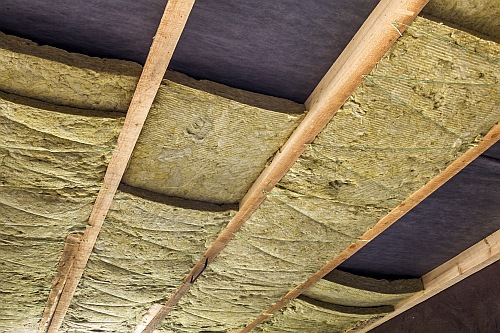Proper roof insulation is one of the best ways to lower your energy bills. Insulation creates an effective barrier between the inside and outside of your home, keeping the temperature you want in and the temperature you don’t want out. This means your HVAC system doesn’t have to work as hard to heat and cool your living space, so you’ll save monthly money.
In this article, our Greenville roof insulation professionals explain everything you need to know about how to properly insulate your home from the elements to achieve significant savings in energy, costs and emissions.
Different Types of Roof Insulation Materials
Roof insulation is typically made of the following types of materials:
Fiberglass
Fiberglass insulation is one of the most common and affordable types of roof insulation. It’s made of tiny fibers of glass and comes in rolls or batts that can be placed between roof rafters—fiberglass works by trapping air pockets, slowing the transfer of heat. The downside is that fiberglass can irritate your skin and lungs, so safety gear like gloves, masks, and protective clothing are necessary when installing.
Cellulose
Cellulose is a natural insulation material made from recycled paper products like newspaper. It’s treated with fire retardants and pesticides before being installed as loose fill in the attic or dense packs in roof cavities. Cellulose is excellent for soundproofing and is very energy efficient. However, it’s more expensive than fiberglass and can settle over time, reducing its effectiveness.
Foam Board
Foam board insulation comes in large panels, usually polystyrene or polyisocyanurate foam. The rigid foam panels are placed over the attic floor or between roof rafters. Foam board is more expensive than loose-fill but is very effective, blocking over 90% of heat transfer. It’s also versatile, acting as both insulation and a vapor barrier. The downside is that the panels can be difficult to cut and install in tight spaces.

Spray Foam
Spray polyurethane foam, or SPF, is a popular roof insulation method where liquid polyurethane foams are sprayed onto roof cavities then expand many times in volume. SPF insulates and air seals, blocking heat, air, and moisture. It can be expensive, but a little goes a long way. SPF also adheres well to surfaces, eliminating gaps. However, it requires professional installation, and the fumes released during application can be hazardous.
How Roofing Insulation Makes Your Home Energy Efficient
One of the best ways to improve your home’s energy efficiency is through proper roofing insulation. When heat escapes through your attic and roof, it costs you money and wastes energy. Installing insulation creates an effective barrier to prevent heat loss and keep your home comfortable.
Choose the Right Type of Insulation
The two most common types of roof insulation are fiberglass and cellulose. Fiberglass insulation is made of fine glass fibers and can irritate your skin, so wear protective gear when installing it. Cellulose is made from recycled paper and is a safer, more eco-friendly option. Both provide excellent insulation, so choose based on your needs and budget.
Install Insulation to Recommended Levels
The recommended level of insulation for most attics is R-30 to R-60, depending on your climate zone. The higher the R-value, the better the insulation. Install insulation evenly and to the proper depth for maximum efficiency. For fiberglass, aim for at least 10 to 15 inches deep, while cellulose insulation should be 18 to 27 inches deep.
Seal and Ventilate the Attic
In addition to adding insulation, it’s important to seal and ventilate your attic to prevent heat loss. Seal any cracks or gaps in the attic floor, especially around pipes, wires, and the attic access door. Installing an attic vent or ridge vent along with soffit vents will improve air circulation and prevent heat buildup in summer.
Consider Radiant Barriers
You can install a radiant barrier in your attic for added energy efficiency. Radiant barriers reflect heat towards its source, reducing heat transfer into your attic space. They can lower attic temperatures by up to 30 degrees in summer. Combining a radiant barrier with proper insulation and ventilation provides one of the most effective solutions for improving your home’s energy efficiency and saving money on utility bills.
Reach Out to Our Greenville Roofing Insulation Specialists for Guidance
When it comes to improving your home’s energy efficiency and comfort, proper roof insulation is key. At Greenville Roofing, we provide affordable, high-quality roofing solutions to help lower your energy bills and increase the value of your home.
Our certified roofers have years of experience installing residential roofing in Greenville, including insulation, ventilation, and radiant barriers. If your attic seems poorly insulated or you want to improve your home’s energy efficiency, call us at (864) 416-4166 for a free estimate.

